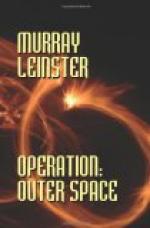There was no debris about. There was no cargo waiting to be loaded. Cochrane did see a great metal plate, tilted on the ground, with a large box attached to it by cables. That would be the generators and the field-plate for a Dabney field. It was plainly to remain on the moon. It was not underneath the ship. Cochrane puzzled tiredly over it for a moment. Then he understood. The ship would lift on its rockets, hover over the plate—which would be generating its half of the field—and then Jones would switch on the apparatus in the ship itself. The forward, needle-pointed nose of the ship would become another generator of the Dabney field. The ship’s inertia, in that field, would be effectively reduced to a fraction of its former value. The rockets, which might give it an acceleration of a few hundred feet per second anywhere but in a Dabney field, would immediately accelerate the ship and all its contents to an otherwise unattainable velocity. The occupants of the rocket would lose their relative inertia to the same degree as the ship. They should feel no more acceleration than from the same rocket-thrust in normal space. But they would travel—
Cochrane felt that there was a fallacy somehow, in the working of the Dabney field as he understood it. If there was less inertia in the Dabney field—why—a rocket shouldn’t push as hard in it, because, it was the inertia of the rocket-gases that gave the rocket-thrust. But Cochrane was much too tired to work out a theoretic objection to something he knew did work. He was almost dozing when Babs touched his arm.
“Space-suits, Mr. Cochrane.”
He got wearily into the clumsy costume. But he saw again that Babs wore the shining-eyed look of rapturous adventure that he had seen her wear before.
They got out of the moon-jeep, one after the other. The sling came down the space-ship’s gleaming side. They got in it, together. It lifted them.
The vast, polished hull of the space-ship slid past them only ten feet away. The ground diminished. They seemed less to be lifted than to float skyward. And in this sling, in this completely unreal ascent, Cochrane roused suddenly. He felt the acute unease which comes of height. He had looked down upon Earth from a height of four thousand miles with no feeling of dizziness. He had looked at Earth a quarter-million miles away with no consciousness of depth. But a mere fifty feet above the surface of the moon he felt like somebody swinging out of a skyscraper window.
Then the airlock opening was beside them, and the sling rolled inward. They were in the lock, and Cochrane found himself pushing Babs away from the unrailed opening. He was relieved when the airlock closed.
Inside the ship, with the space-suits off, there was light and warmth, and a remarkably matter-of-fact atmosphere. The ship had been built to sell stock in a scheme for colonizing Mars. Prospective investors had been shown through it. It had been designed to be a convincing passenger-liner of space.




